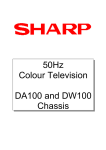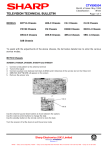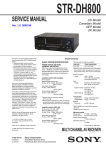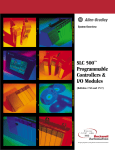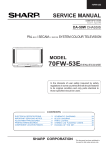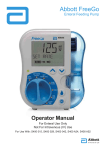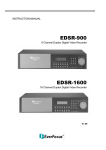Download 50Hz Colour Television DA100 and DW100 Chassis
Transcript
50Hz Colour Television DA100 and DW100 Chassis Colour Television – DA100/DW100 Chassis Contents POWER SUPPLIES...........................................................................................................................1 Switch Mode Power Supply......................................................................................................1 Start up operation...........................................................................................................1 Voltage regulation ..........................................................................................................2 Over-voltage Protection..................................................................................................2 Over-current control .......................................................................................................2 Slave Processor Power Supply.................................................................................................3 Degauss Circuit........................................................................................................................4 5v Regulator ............................................................................................................................5 DA100 (59ESD7H and 66ESD7H) 4:3 chassis................................................................5 DW100 (56FW53H to 6FW54H) 16:9 chassis .................................................................6 CLASS D OUTPUT STAGES ............................................................................................................7 Tda7480 Pin Functions.............................................................................................................7 Pin 9 – Frequency ..........................................................................................................7 Pin 12 – Mute/Standby function ......................................................................................7 Audio Output............................................................................................................................8 Field Output .............................................................................................................................9 Vertical Fly-back...........................................................................................................10 VIDEO AND SYNC PROCESSOR ...................................................................................................11 Description.............................................................................................................................11 Analogue front-end.......................................................................................................11 Input Selector...............................................................................................................11 Clamping......................................................................................................................11 Automatic Gain Control ................................................................................................12 Analogue-to-Digital Converters.....................................................................................12 Digitally Controlled Clock Oscillator ..............................................................................12 Analogue Video Output ................................................................................................12 Average Beam Current Limiting....................................................................................12 Protection Circuitry .......................................................................................................12 Scan Velocity Modulation Output ..................................................................................12 PICTURE ROTATION......................................................................................................................13 SCAN VELOCITY MODULATOR ....................................................................................................14 LINE OUTPUT STAGE....................................................................................................................15 East West Circuit....................................................................................................................16 Circuit Description ........................................................................................................16 MICROPROCESSOR CONTROL ....................................................................................................17 Reset .....................................................................................................................................18 PROTECTION .................................................................................................................................19 Microprocessor.......................................................................................................................19 Audio Output ................................................................................................................19 Beam Current...............................................................................................................19 Horizontal Mute ............................................................................................................19 Video/Sync Processor ............................................................................................................20 Safety ..........................................................................................................................20 Vprot ............................................................................................................................20 Sharp Electronics (UK) Ltd Technical Support September 99 Colour Television – DA100/DW100 Chassis POWER SUPPLIES This CTV employs two power supplies, which are similar in design to previous models. The Power Supply located on the sub-board 'PWB-C' will supply the Dolby Prologic circuit and Audio Output Stages that are also located on PWB-C. Similar to the CS, CA10 and CW100 chassis, when this receiver is in standby mode, the outputs from the power supplies (including the supply to the Main Microprocessor circuit) will be muted by removal of the FET gate voltage. The Slave Processor (IC702) performs standby and timer on/off functions, additionally in this chassis the Slave Processor will control the degauss circuit. SWITCH MODE POWER SUPPLY +8v +HT T701 17 R715 47k R713 560k R714 560k C710 47nF D718 C718 1000 D719 C719 1000 4 To Degauss Circuit D712 15v C714 82nF R717 22k D720 R719 220 Q702 D730 R716 0R47 Q703 C738 56pF C713 68nF C715 330pF R718 18 R723 270 D716 5v6 C717 15nF 150V C720 100 12 R766 220 6 15 D713 +16v -16v 5 R730 82 D721 8v2 3 Q701 C711 330pF R727 180 7 D711 C712 100pF 8 R728 180 1 R765 220 D715 R722 0R33 C718 3n3 14 2 IC705 D726 12v R743 47k Standby R724 470 R750 1M R744 47k IC706 R745 1k8 R746 47k START UP OPERATION Rectified and smoothed mains voltage (+320VDC) is used to provide the start up voltage to the gate of Q701. Current flows via R713 and R714 charging C714 (C714 earth return is via T701 secondary winding pins 14 and 15). This allows a voltage at the gate of Q701 to rise slowly (Q701 will turn on when the gate reaches 4.5V). D712 ensures that Q701 gate voltage will not exceed 15V, preventing the FET being damage by voltage spikes. When Q701 turns on, current will flow from the bridge rectifier, through T701 primary winding (pins 12 and 17), Q701 source/drain junction, returning to the bridge rectifier via, R716. The current flowing through T701 primary will induce an e.m.f. into secondary windings The e.m.f. produced at T701 pin 15 will flow through D715 and the collector emitter junction of the opto-coupler (IC705), charging C713. Once the charge on C713 reaches 0.6V Q703 will turn on, connecting Q701 gate to ground, turning Q701 off and discharging C714. Sharp Electronics (UK) Ltd Technical Support September 99 Page 1 Colour Television – DA100/DW100 Chassis At this point, the magnetic field within T701 will collapse causing the e.m.f at pin 15 to go negative turning Q703 off. Q701 will not turn on until sufficient charge has built up on C714. However, at this time the negative plate of C714 is approximately -12V; due to the collapsing field within T701. This results in the time period required to build sufficient charge on C714 to bias Q701 on increasing i.e. Q701 off time = the time for the back 'e.m.f.' to decade to zero, plus C714 charge time form zero to 4.5V approx.). VOLTAGE REGULATION The feed back through the opto-coupler (IC705), provides voltage regulation. The +150V line is used as the controlling source and a reference is provided from the +16v supply. Increase in load As the +150V rail falls due to an increase in load (high beam current), the trigger voltage of IC706 will fall, increasing IC706 cathode voltage, reducing the current flowing through the LED section of IC705. This has the effect of decreasing the conduction of the photo transistor part of IC705. This increases the voltage drop across the collector/emitter junction; thereby increasing the time taken to charge C713, delaying the point when Q703 turns on, turning Q701 off. Energy is transferred across T701 for a longer period, increasing the HT rail; hence, the frequency of the power supply will fall. Decrease in load As the +150V rail increase due to a decreasing load (low beam current), the trigger voltage of IC706 will rise decreasing IC706 cathode voltage which increases the current flow through the LED section of IC705. This has the effect of increase the conduction of the phototransistor within IC705. Thereby decreasing the voltage drop across the collector/emitter junction; which will decrease C713 charge time, advancing the point when Q703 turns off, turning off Q701 to turn on earlier. Energy is transferred across T701 for a shorter period, decreasing the HT rail; hence, the frequency of the power supply will increase. It can now be seen that this is a variable frequency power supply, typically the frequency will vary between 144kHz (no load) to 70kHz (high beam current). OVER-VOLTAGE PROTECTION D716 is used to prevent the secondary rails increasing beyond safe limits. If the e.m.f. at T701 pin 15 increases beyond safe limits D716 will conduct, increase the voltage across C713, thereby reducing its charge time, turning on Q703 earlier, turning off Q701, allowing the HT rails to fall. Once the HT starts to fall Q703 will turn off allowing the Power Supply to restart. OVER-CURRENT CONTROL Over current control is performed by monitoring the amount of current passing though the R716 (Q701 drain, earth return resistor). This resistor is an extremely low value, 0.47R, and Ohms Law dictates that the current flowing through it must be proportional to the voltage across it. The base voltage required for turning on Q702, is +0.6V then the voltage across R706 to ‘trip’ the circuit would have to be approximately 1.2V (this includes 0.6V drop across D720). Therefore a current of 2.5amps is required to operate the trip circuit. The voltage developed across R716 will turn Q702 on via D713 and R719. Once Q702 turns on, C714 will discharge rapidly, removing Q701 gate bias. Q701 will remain turn off until the current through R716 decreases. At this point Q702 turns off allowing C714 to charge turning on Q701. If the overload is still present then Q702 will turn on again, thus repeating the cycle. In the case of a short circuit line output transistor the power supply will keep repeating this cycle. The HT rail and base of Q702 (if measured with a standard DVM) would normally read zero volts and the power supply appears not to be working. On some occasions when the short is not as heavy then a whistle may be heard. Sharp Electronics (UK) Ltd Technical Support September 99 Page 2 Colour Television – DA100/DW100 Chassis SLAVE PROCESSOR POWER SUPPLY This part of the circuit has changed compared to previous chassis, where this supply was derived by means of a bridge rectifier with two additional 68k resistors and a 5v1 zener diode to limit the voltage. This has been replaced by a series regulator circuit, which is supplied from one side of the mains, with an earth return via the bridge rectifier. D708 and D707 forms part of a bridge rectifier, two diodes of the main bridge rectifier are used for the other part. Therefore, at the junction of D707 and D708 there is a 100Hz signal comprising of positive halve cycles at mains potential. Each time this signal exceeds 47v D729 will conduct, turning on Q717. D734 R771 470k D731 HT D707 R774 470k R775 470k D732 15v R703 150k R777 47 Q715 +5v C739 220 D710 5v1 C724 220 D733 D729 47v R776 82k R721 150k R770 220 D708 R738 47k R735 470k R739 47k R736 470k Q717 Clock Q708 Q709 R737 180k C725 4n7 R787 47k When Q717 turns on the gate of Q715 is taken to ground. Since this is a N Channel MOSFET Q715 is turned off and no current will flow through this device. During the period when Q717 is turned off Q715 will turn on allowing C739 to charge to approximately 7v which is limited to 5v by R777 and D710. It can now be seen that the period of Q715 conduction is very short (it is only turned on when the 100Hz signal at the junction of D707 and D708 is less than 47v). Therefore, a top-up supply from the bridge rectifier circuit comprising of D734 and D731 is added to the cathode of D710 via R721 and R703. The 100Hz signal at the junction Q717 and D733 is also used as a timing signal for the real time clock within the slave processor. However, before it can be used the signal is passed through a Schmitt Trigger circuit (Q708 and Q709) to ensure that the signal free from noise. Sharp Electronics (UK) Ltd Technical Support September 99 Page 3 Colour Television – DA100/DW100 Chassis DEGAUSS CIRCUIT This circuit is configured to ensure that the degauss circuit will not operated unless the switch mode power supply is operating and IC702 pin 14 = low. A positive bias is applied to the emitter of Q714 from T701 pin 15 (rectified by D727 and limited by D728). Via the opto-coupler; IC708. Since Q714 is a pnp device once the base is taken low compared to the emitter, Q714 will turn on allowing current to flow through IC708 (LED Section), turning on the triac T702, allowing current to flow through the degauss coils. N T702 POR701 C702 10nF Degause Coils L D728 4v7 IC708 R768 220 R763 100 Q714 From IC702 pin 14 R762 220 D727 From T701 pin15 Current will continue to flow through the degauss coils until either the PTC (POR701) has increased in value sufficiently to cut off the current flow, or IC702 pin 14 goes high, turning of Q714, preventing current flow through IC708, turning the triac T702 off. Since the default condition for IC702 = low, it can be seen that the degauss circuit should now operate each time the CTV is turned on from the main on/off switch or switched from standby to normal operation. Whether the main processor has set up communication with the slave processor or not. Sharp Electronics (UK) Ltd Technical Support September 99 Page 4 Colour Television – DA100/DW100 Chassis 5V REGULATOR This is another new circuit, but depending on whether you are dealing with the DA100 (4:3) chassis or DW100 (16:9) chassis will determine the exact circuit. DA100 (59ESD7H AND 66ESD7H) 4:3 CHASSIS The FET Q704 is a series regulator producing 5v, which is controlled by Q713. A voltage is fed-back from the output of Q704 (junction of L705 and C723) which will control the conduction of a variable zener diode (IC707). D723, Q705 and Q706 provide protection against excessive supply voltage. D722 +16v C735 150pF C722 10nF R707 1k5 Q713 R757 2k2 From T701 pin 1 D714 R726 22 R710 2k2 R725 10k R706 8k2 R760 4k7 R729 4k7 Q704 C734 470 C721 470 L705 Q706 IC707 +5v D723 2v7 R731 10k R756 10k Q705 C723 2200 Sharp Electronics (UK) Ltd Technical Support September 99 Page 5 Colour Television – DA100/DW100 Chassis DW100 (56FW53H TO 6FW54H) 16:9 CHASSIS For models using the DW100 chassis this regulator circuit has been replaced by an integrated circuit (L4978D). R748 4k7 C742 68nF D722 11 T701 pin 1 C721 470 C743 100nF C735 2n7 R706 20k R747 2k7 14 +5v IC707 C722 100nF 4 L705 13 3 C741 100nF 5,6 2 D714 This DC-DC converter will operate from a supply between 8v to 55v and produces an output voltage of between 3v3 and 50v depending on the value of R747 (5v output R747 = 2k7). C741 connected to pin 3 provides a soft-start routine. If pin 3 is held low then the device will not operate. The frequency of the internal oscillator is fixed by the value of R706 and C735. Over-current and over-voltage protection is incorporated into the design of this device. Sharp Electronics (UK) Ltd Technical Support September 99 Page 6 Colour Television – DA100/DW100 Chassis CLASS D OUTPUT STAGES The class ‘D’ output stages that Sharp Electronics have used since the introduction of the CS chassis are now incorporated into a specially design integrated circuit (TDA7480 = 10w output power, TDA7481 = 15w output power and TDA7482 = 25w output power). These devices are ideal for use with TV Audio & Field output stages where high efficiency (low energy use) is required. Sharp Electronics are currently using the TDA7480 for Audio and Frame outputs and the TDA7481 to drive the sub-woofer. T DA7480 PIN F UNCTIONS Pin No. 1 2 3 4 5 6 7 8 9 10 11 12 13 14 15 16 17 18 19 20 Name -VCC -VCC -VCC OUT BOOTDIODE BOOT NC FEEDCAP FREQUENCY SGN-GND IN ST-BY-MUTE NC +VCC SIGN VREG +VCC POW -VCC -VCC -VCC -VCC Function NEGATIVE SUPPLY. NEGATIVE SUPPLY. NEGATIVE SUPPLY. PWM OUTPUT BOOTSTRAP DIODE ANODE BOOTSTRAP CAPACITOR NOT CONNECTED FEEDBACK INTEGRATING CAPACITANCE SETTING FREQUENCY RESISTOR SIGNAL GROUND INPUT ST-BY/ MUTE CONTROL PIN NOT CONNECTED POSITIVE SIGNAL SUPPLY 10V INTERNAL REGULATOR POSITIVE POWER SUPPLY NEGATIVE SUPPLY (De-coupled by 100nF) NEGATIVE SUPPLY NEGATIVE SUPPLY NEGATIVE SUPPLY PIN 9 – FREQUENCY The external components on this pin will determine the base frequency of the PWM section of this IC. Remember for the audio circuit the frequency will vary from the base frequency by the bandwidth of the audio signal (20kHz). PIN 12 – MUTE/STANDBY FUNCTION The voltage at pin 12 will determine the working condition of this device. A voltage of less than 0.8v will tell the device to switch to standby, where a voltage between 1.8v to 2.5v will result in the output being attenuated between 60 to 80 dB. For normal operation the voltage at pin 12 should be greater than 4v. Sharp Electronics (UK) Ltd Technical Support September 99 Page 7 Colour Television – DA100/DW100 Chassis AUDIO OUTPUT At switch on C362 is discharged holding IC301, pin 12 low preventing any output from IC301 until supply has been established. Once supply has been established and IC301, pin 12 is greater than 4v then the IC301 will start to oscillate, producing a PWM signal with a frequency and a mark space ratio which is dependant on the input signal at pin 11. L352 and C361 form a low pass filter for conversion of the PWM signal into an analogue signal to drive the loudspeaker. A proportion of this drive signal is fed into an averaging circuit via R358 as a protection signal i.e. if the average of the signal at the junction of R358 and L352 is not zero then the software will switch the CTV to standby mode. +5v R350 10k R351 27k +16v Left Channel Q305 C362 2.2 Mute R362 4k7 12 St-By/Mute 14 Vcc sign 7,13 N.C Boot 6 TDA7480 C356 15nF 11 Input R372 10k 16 Vcc pow C357 1nF R375 47k -PRE 4 + 8 C360 560pF Feedcap IC301 5 Boot Diode Sign-GND C359 4n7 10 -Vcc 1,2,3,18,19,20 Freq 9 C354 100pf 200kHz L352 -PWM + C353 100nF -16v -Vcc 17 15 Vref R353 150 C361 470nF R358 100k C358 100nF Protection R352 12k MUTE During system reset or when the ‘Line Mute (HOUT)’ is present, the audio outputs will be muted due to an increase in Q305 base bias, turning it on. The circuit description/diagram for this mute signal is shown on page 19. Sharp Electronics (UK) Ltd Technical Support September 99 Page 8 Colour Television – DA100/DW100 Chassis FIELD OUTPUT The operation of the field output circuit is similar to the audio with the exception that there is no mute circuit except for C511, which will stop the circuit from operating until the +13v supply, is present. +5v +13v R509 39k Vertical Flyback 12 St-By/Mute R544 1k Input 16 Vcc pow C511 2.2 14 Vcc sign 7,13 N.C TDA7480 11 -PRE C524 330nF 6 L352 -PWM + C505 100nF Boot 4 + C508 560pF 8 Feedcap IC501 5 Boot Diode Sign-GND 10 C507 4n7 -Vcc 1,2,3,18,19,20 Freq 9 C503 100pf R502 4k7 R515 1k2 R510 8k2 IC502 -Vcc 17 -13v R503 1k R511 150 15 Vref C534 1nF C506 100nF Vertical Flyback 3 Q503 Field Coils R518 1R C504 680nF R533 1R R501 150 R516 1k 1 R512 4k7 2 The PWM signal from pin 4 of the IC, is passed through a low pass filter (L352 and C504) producing a ramp signal at the field deflection coils. This ramp waveform will vary between +13v when the scan is at the top of the screen decreasing to –13v when the scan has reached the bottom of the screen. The field scan coils are returned to ground via Q503. Q503 is turned on during the vertical scan period and turn off during vertical fly-back. IC502 will produce an error signal. This error signal is fed to the vertical drive input (IC501 pin 11), for the purpose of linearity and amplitude correction. Sharp Electronics (UK) Ltd Technical Support September 99 Page 9 Colour Television – DA100/DW100 Chassis VERTICAL FLY-BACK At the point where vertical fly-back is initiated Q503 turns off and Q502 turns on allowing +25v to flow from Q502 emitter to the field scan coils. Since there is –13v on the other side of the scan coils derived from the vertical drive signal, we effectively have 38v across the field coils, which will force the electron beam to the top of the screen. The vertical drive signal that is outputted from IC801 pin 31 has a negative going pulse in addition to the normal ramp waveform. This negative pulse is used to initiate vertical fly-back. This drive signal is applied to the emitter of Q505 via R508. The potential divider R526 and R514 will fix Q505 base voltage so that it will only turn on during the period of the negative going pulse. Once Q505 turns on its collector voltage will fall turning on Q507 taking its emitter to ground, which results in: Q503 turns off due to the removal of gate bias Q502 turns on allowing +25v at the junction of Q502 collector and the scan coils due to the action D507 conducting secondly enabling D507 to conduct. +25v R504 39k +5v R526 4k7 R547 3k9 D508 R505 2k2 Q502 Q507 R506 120 Q505 VProtect R528 100k R514 390 R508 680 D507 12v C512 220nF R517 15k Field Scan Coils Q503 R507 8k2 Drive Field Output V Prot Signal From the Junction Q502 collector and the scan coils the vertical fly-back pulse is applied to IC801 pin 11 (Vprot Signal) as an indicator of vertical output stage operation. If IC801 cannot detect the negative edge of this pulse the IC801 will presume that the vertical stage is not operating correctly and blank the RGB drive. Sharp Electronics (UK) Ltd Technical Support September 99 Page 10 Colour Television – DA100/DW100 Chassis VIDEO AND SYNC PROCESSOR This IC is a member of the ‘Micronas’ VDP 31xxB IC family, which are high-quality video processors Allowing the economic integration of features in all classes of TV sets. The VDP 31xxB family is based on functional blocks contained in the two previous chips form Micronas: VPC 3200A Video Processor DDP 3300A Display and Deflection Processor VDP 31xxB contains the entire video, display, and deflection processing for 4:3 and 16:9 CTV’s operating at either 50 or 60Hz featuring: 2H adaptive Comb-filter Scan Velocity Modulator. 1H Comb-filter Colour Transient Improvement. RGB Insertion Tube Control Programmable RGB Matrix 4 composite inputs (one for S-VHS) Composite video & sync output Horizontal scaling (0.25 to 4) Panorama vision Black level expander Dynamic peaking Soft-limiter (gamma correction) Picture frame generator High-performance H/V deflection Separate ADC for tube measurements EHT compensation One 20.25 MHz crystal (for all systems), few external components Embedded RISC controller (80 MIPS) I 2 C-Bus Interface Single 5 V power supply DESCRIPTION ANALOGUE FRONT-END This block provides the analogue interfaces to all video inputs and mainly carries out analogue-to digital conversion for the following digital video processing. Most of the functional blocks in the front-end are digitally controlled (clamping, AGC, and clock-DCO). The control loops are closed by the Fast Processor (‘FP’) embedded in the decoder. INPUT SELECTOR Up to five analogue inputs can be connected. Four inputs are for input of composite video or S-VHS luma signal. These inputs are clamped to the sync back porch and are amplified by a variable gain amplifier. One input is for connection of S-VHS chrominance signal. This input is internally biased and has a fixed gain amplifier. CLAMPING The composite video input signals are AC coupled to the IC. The clamping voltage is stored on the coupling capacitors and is generated by digitally controlled current sources. The clamping level is the back porch of the video signal. S-VHS chroma is also AC coupled. The input pin is internally biased to the centre of the ADC input range. Sharp Electronics (UK) Ltd Technical Support September 99 Page 11 Colour Television – DA100/DW100 Chassis AUTOMATIC G AIN CONTROL A digitally working automatic gain control adjusts the magnitude of the selected base-band by +6/–4.5 dB in 64 logarithmic steps to the optimal range of the ADC. The gain of the video input stage including the ADC is 213 steps/V with the AGC set to 0 dB. ANALOGUE-TO-DIGITAL CONVERTERS Two ADCs are provided to digitise the input signals. Each converter runs with 20.25 MHz and has 8 bit resolution. An integrated band-gap circuit generates the required reference voltages for the converters. DIGITALLY CONTROLLED CLOCK OSCILLATOR The clock generation is also a part of the analogue front end. The crystal oscillator is controlled digitally by the control processor; the clock frequency can be adjusted within ±150 ppm. ANALOGUE VIDEO OUTPUT The input signal of the Luma ADC is available at the analogue video output pin. A source follower must buffer the signal at this pin. The output voltage is 2 V, thus the signal can be used to drive a 75Ω line. The magnitude is adjusted with an AGC in 8 steps together with the main AGC. AVERAGE BEAM CURRENT LIMITING The average beam current limiter (BCL) uses the sense input for the beam current measurement. The BCL uses a different filter to average the beam current during the active picture. The filter bandwidth is approximately. 2 kHz. The beam current limiter has an automatic offset adjustment that is active two lines before the first cut-off measurement line. The beam current limiter allows the setting of a threshold current. If the beam current is above the threshold, the excess current is low-pass filtered and used to attenuate the RGB outputs by adjusting the white-drive multipliers for the internal (digital) RGB signals, and the analogue contrast multipliers for the analogue RGB inputs, respectively. The lower limit of the attenuator is programmable, thus a minimum contrast can always be set. During the CRT measurement, the ABL attenuation is switched off. After the white drive measurement line it takes 3 lines to switch back to BCL limited drives and brightness. PROTECTION CIRCUITRY ‘Vertical fly-back’ and the ‘Safety’ inputs provide picture tube and drive stage protection. Vertical fly-back; This pin searches for a negative edge in every field, otherwise the RGB drive signals are blanked. Drive shutoff during fly-back: this feature can be selected by software. Safety; Input pin: this input has two thresholds. Between zero and the lower threshold, normal functioning takes place. Between the lower and the higher threshold, the RGB signals are blanked. Above the higher threshold, the RGB signals are blanked and the horizontal drive is shut off. Both thresholds have a small hysteresis. The main oscillator and the horizontal drive circuitry are run from a separate (standby) power supply and are already active while the TV set is powering up. Note: In the DA100 and DW100 chassis the standby supply pin is connected to VCC. SCAN VELOCITY MODULATION OUTPUT This output delivers the analogue SVM signal. The D/A converter is a current sink like the RGB D/A converters. At zero signal level the output current is 50% of the maximum output current. Sharp Electronics (UK) Ltd Technical Support September 99 Page 12 Colour Television – DA100/DW100 Chassis PICTURE ROTATION Due to the width of a 16:9 CRT the horizontal tilt of the picture can be influence by external magnetic fields. To overcome this problem, an extra coil is fitted around the CRT, which is connected between the junction of Q1603/Q1604 emitter and ground. The microprocessor (IC1001) will output a PWM signal from pin 55. This signal is then passed through a LPF and fed to an error amplifier (IC601). The output from this error amp can swing from a positive to a negative voltage depending on the mark space ratio of the PWM signal from IC1001. +13v C1612 220 R1615 1M 1kHz PWM IC1001, pin 55 R1620 10k R1619 100k C1608 10 R1617 2k2 D1607 2v4 C1611 10nF R1616 100k Q1603 R1622 470 IC1601 R1618 100k + R1621 100 R1624 100 Tilt Coils Q1604 C1609 10 C1610 100nF R1623 100 -13v C1613 220 Under normal conditions (CRT is not effected by external magnetic fields) there will be no output from the error amplifier, therefore, both Q1603 and Q1604 are turned off causing no current to flow through the coil around the CRT neck. However if the output from the error amplifier is positive then Q1603 will turn on allowing current to flow from the +13v rail, through the coil to ground. If the error amplifier output is negative going then Q1604 will turn on, allowing current to flow from ground to the –13v rail. The end user has control of this adjustment via the picture menu. Note The location of this circuit can vary between 66cm models (Located on CRT base) and 76cm models (located on sub PWB). Sharp Electronics (UK) Ltd Technical Support September 99 Page 13 Colour Television – DA100/DW100 Chassis SCAN VELOCITY MODULATOR The purpose of this circuit is to maintain the luminance level as the electron spot moves across the CRT face. The distance that the electron beam travels from the electron gun to the CRT face at the outer edges of the CRT is greater than the distance from the electron gun to the centre of the CRT face. This distance is emphasised more on 16:9 CRT’s than 4:3 CRT’s with deflection angles of 110° This result in the intensity of the electron spot varying as it travels across the CRT face. To overcome this a coil is placed around the CRT neck, close to the gun assembly. The purpose of this coil is to increase/decrease the speed, the spot travels across the CRT face, therefore, maintaining luminance transitions. 140v +12v R5425 470 R5415 82 Q5405 R5431 390 R5432 33 R5433 100 R5413 C5408 10 68nF R5412 47 IC801 pin 34 Q5410 +5v Q5412 R5434 1k Q5406 R5435 220 R5416 3k3 R5417 0 R5423 3R3 Q5407 SVM Coils R5414 10 Q5411 R5410 0 C5409 68nF R5418 3k3 Q5408 R5419 82 R5421 3R3 R5411 0 The signal that is used to control this circuit is derived from IC801 pin 34 and the amount of correction can be adjusted by the end user via the picture menu. Sharp Electronics (UK) Ltd Technical Support September 99 Page 14 Colour Television – DA100/DW100 Chassis LINE OUTPUT STAGE As in previous chassis a transformer-less driver circuit has been used, with the driver stage obtaining it’s run voltage from the fly-back transformer, T601. At switch on +8v from the power supply is applied to Q603 collector via R605 and Q602 collector via R628 and R608. At the same time –16v is applied to Q602 emitter via R619. Horizontal drive from IC801 is applied to the base of Q603, This will cause Q603 to switch, which in turn switches the line output transistor Q601, producing an e.m.f on pins 6 and 10 of the fly-back transformer T601. The e.m.f at pin 10 is rectified by D611 to produce the positive run voltage and the e.m.f at pin 6 is rectified by D610 to produce the negative run voltage. D611 +150v L606 R608 1k +8V R617 22 Q601 L609 C610 27nF Q603 Line Drive R612 22 R601 3k9 R642 470 C601 12nF Focus 7 +150v (CRT Base) R628 1k EHT 2 D621 R605 470 R607 12k R623 1 Screen 3 13 D603 8 ABL 10 D604 East/West Circuit 1 4 R617 22 6 +25v 5 9 +13v Q602 R624 D610 5R6 R619 560 HFB D510 D609 F602 D608 F601 -13v C607 330 -16v With this type of driver circuit, it is essential that the circuit is started softly, otherwise transient pulses can damage the line output transistor. This is achieved by doubling the horizontal drive frequency; which effectively reduces Q601 on time, until the run voltage has been established. In addition to producing the EHT, focus, screen voltage and horizontal scan from the fly-back transformer T601, the +/-13v rails for the field output are produced at pins 5 and 9. D609 rectifies the e.m.f at pin 9 producing the +13v and D608 rectifies the e.m.f at pin 5 producing the –13v. Horizontal fly-back pulses (HFB) from pin 1 is fed to IC801 for both timing purposes and safety (prevents excesses EHT), HFB is also rectified by D610 to produce +25v for vertical fly-back. From the primary winding (pin 7) the HT is stepped up and rectified by D621 to produce the HT required by the CRT drive circuit. Finally a negative going voltage is fed from pin 8 to the protection circuit. This voltage represents the beam current. The greater the beam current (Bright Raster) the greater this voltage would be in a negative direction. This negative voltage is then fed to the IC1001 pin 95 via D622 and Q606. Once this voltage has exceeded safe working levels IC1001 pin 95 will go low switching the CTV to standby. Sharp Electronics (UK) Ltd Technical Support September 99 Page 15 Colour Television – DA100/DW100 Chassis EAST WEST CIRCUIT In addition to the normal function of an East West correction circuit used with 4:3, 110° CRT, with a wide screen CTV correction has to be allowed for the different types of scanning modes. 16:9 CTV generally has three scanning modes, 4:3, 14:9 and 16:9, additionally the 16:9 scanning modes has three variants, Full, Panama and Cinema. Full mode is used to stretch a picture which is in 4:3 format and contains fast moving action (motor racing), therefore, it does not matter if the line linearity is not constant across the screen. Panama is similar to full mode but this time the action is slow or even stationary (news programs), therefore, your eye would pickup on any variation in linearity. To overcome this the linearity in the centre of the screen is kept constant and the edges of the picture are stretched to fill the screen. Cinema mode is intended for use with pictures that are in true 16:9 format. R555 100k +150v D506 R613 2k2 C518 10pF R527 1k R525 5k6 R524 1k Q501 Line Drive Q601 (c) +5v +5v R519 100k Scan Coils R556 10k C514 47nF R610 1 + C620 2.2 Q506 R525 10k D503 EW Drive D613 C613 560nF C619 2.2 L605 L603 C611 1 RA611 3k3 L604 IC503 Diode Modulator CIRCUIT DESCRIPTION IC503 is a switching amplifier with integrated line pulses being fed to one input from the line driver circuit via Q501 and an East West parabolic signal from IC801 to the other input. This will produce a PWM signal running at line frequency and the width of the pulses will be determine by the East West parabolic signal. This signal is then passed a driver circuit (Q506, class ‘d’ biased), low passed filtered (L603, C610) to the diode modulator (D603 and D604). Additionally from L603 the signal is fed to one end of a centre tap coil (L604) via C611. The other of L604 is connected to ground with the centre tap connected to the line linearity circuit. Therefore the line linearity can now be adjusted by the East West Parabolic signal. Sharp Electronics (UK) Ltd Technical Support September 99 Page 16 Colour Television – DA100/DW100 Chassis MICROPROCESSOR CONTROL The microprocessor (CPU) is at the hart of this CTV, communicating with all other area via various data buses. Similar to the CS, CA10 and CW100 chassis this CPU is not operating during standby, therefore contained in the primary side of the power supply there is a slave processor. This slave processor has a volatile memory, therefore each time power is applied to this CTV the switch mode powers supply has to start enabling the slave processor program to be downloaded from the OTProm before switching to standby. I2S Bus Dolby Processor Multi-Sound Processor Video/Sync Processor IF Tuner IC2028 I2C Bus (1) AFT-1 AFT-2 Slave Processor OTP NVM (eeprom) IC1001 (CPU) Main Reset Reset out (1) Reset out (2) AV Link Data AV Link Clock Protection I2C Bus (2) M3 Bus NVM (eeprom) Page Store MegaText PARALLEL BUS Communication between the CPU and the OTProm (one time programmable read only memory). This device contains the software (operating system) 2 2 I2C BUS There are two I C buses, I C(2) communicates between the NVM’s (eeprom), these devices contains data relating to all adjustments, whether it is an end user 2 adjustment, service adjustment or an automatic setting performed by the CPU. I C(1) provides serial data communications between the CPU and Tuner, Video Processor, Multi Sound Processor and the Dolby Processor (if fitted). M3 BUS Data communication between CPU and the teletext processor (MegaText) SLAVE Data bus to the slave processor an a data us from the slave processor. RESET IN Main system reset, this will operate each time the main switch mode powers supply starts. Reset is a state change from low to high generated by IC1005. RESET OUT (1) IC801 reset (low). If IC801 is not reset then the line oscillator will not function. This will only occur after reset in. RESET OUT (2) Resets all other areas of this CTV, this will only occur after reset out (1). Teletext reset is inverted. PROTECTION If the CPU pin 96 goes low the CTV will switch to standby. This is trigged by one of the audio output stages or excessive beam current. Sharp Electronics (UK) Ltd Technical Support September 99 Page 17 Colour Television – DA100/DW100 Chassis RESET It can be seen from the diagram below that all of the reset signals are a change in state, either form low to high or high to low. The order of events is as shown, supply, reset in, reset out (1), Reset out (2). The line oscillator will not start until reset out (1) has occurred and the HOUT pulse = zero 3v3 Low Reset in Low Reset out (1) Low Reset out (2) Low Low MegaText Reset From Reset out (2) Low HOUT IC1001 pin 57 Low PROT IC1001 pin 95 Line Drive Start Power Supply Start Sharp Electronics (UK) Ltd Technical Support September 99 Page 18 Colour Television – DA100/DW100 Chassis PROTECTION MICROPROCESSOR AUDIO OUTPUT The outputs from all of the audio output stages are fed to the base of Q303 and Q304. C377 and R361 form an averaging circuit. Since the audio signals are basically sine waves the d.c. voltage at the base of these transistors +5v should be zero. If this base voltage was to increase in a R1021 positive direction Q303 will turn 4k7 D301 on, removing the biased from Protection IC1001 pin 95, and the CTV will IC1001 pin 95 Q303 switch to standby. Q302 Q606 The same is true if the base voltage increase negatively, this time Q304 will turn on, turning on Q302 causing IC1001 pin 95 to fall and the CTV will again switch two standby. R360 10k Q304 Audio -16v C377 10 R361 10k C644 2200 D622 27v R615 5k6 ABL (T601 pin 8) BEAM CURRENT If the beam current increase D622 will conduct, turning on Q606 which removes the bias from IC1001 pin 95. The CTV will switch to standby HORIZONTAL MUTE During the boot sequence the horizontal drive is inhibited by the HOUT signal from the microprocessor (IC1001 pin 57). R1005 4k7 5v 1 C1028 100nF 3v3 Q1004 R1044 10k IC1005 3 2 Mute D1009 C1033 68nF Line Drive Main Reset R1047 10k Q602 R626 4k7 R1049 10k 3v3 HOUT IC1001 pin 57 Its function is to remove the line drive by turning on Q607, thus placing short between the horizontal drive signal and ground, at the same time this HOUT pulse will cause the audio mute circuits to activate, preventing any noise from the speakers. Additionally HOUT signal will occur when the microprocessor can not communicate with the other devices connected to the I²C buses Sharp Electronics (UK) Ltd Technical Support September 99 Page 19 Colour Television – DA100/DW100 Chassis VIDEO/SYNC PROCESSOR The video/sync processor (IC801) contains protection circuit that can monitor the scanning circuits operation. D617 24v D615 12 R615 1k Safety C617 100nF HFB +5v R620 1k IC801 Q608 HFB 13 11 D618 4v7 C643 10nF R644 220 Vprot SAFETY IC801 pin 12, EHT is calculated by measuring the rectified horizontal fly-back pulse. D615 and C617 are the rectifier components, and D617 limits the bias at pin 12 (sets normal conditions, >1v) There are two thresholds once the first threshold has been met the RGB drives are blanked, if the d.c. voltage continues to rise and passes the second threshold, then the horizontal drive is stopped. VPROT This pin is monitoring the operation of the vertical output stage. The vertical fly-back pulses are applied to pin 11. If the negative edge of this signal cannot be detected then the RGB drives are blanked. Sharp Electronics (UK) Ltd Technical Support September 99 Page 20 Colour Television – DA100/DW100 Chassis A V Link This CTV chassis has the capability of directly controlling a VCR via the SCART socket or the VCR controlling the CTV. In either chase the VCR must be compatible with the ‘A V Link’ system, also during the installation of the CTV and VCR you will decide whether it is the CTV or VCR which has overall control. +5v R1032 27k R1023 220 92 RGB Scart pin 10 D1003 IC1001 16 R1033 10k D411 5v6 AV-1 Scart pin 10 Q1005 +5v R1025 10k 21 R1035 4k7 Service Data AV-1 Scart pin 12 Data from the CTV to VCR is from IC1001 pin 16 via Q1005 and is outputted from pin 10 either AV-1 or RGB SCART sockets. Data from VCR is from the same SCART connection but this time it is fed into IC1001 pin 92 via D1003. D411 provides protection from excess voltage being applied to the SCART sockets. In addition to this data is outputted at AV-1 SCART pin 12, this data is intended to be read by a computer, enhancing fault finding procedures. Currently this system is still being developed, more details will be given when the software and interface becomes available. Sharp Electronics (UK) Ltd Technical Support September 99 Page 21 Colour Television – DA100/DW100 Chassis Sharp Electronics (UK) Ltd Technical Support September 99 Page 22


























